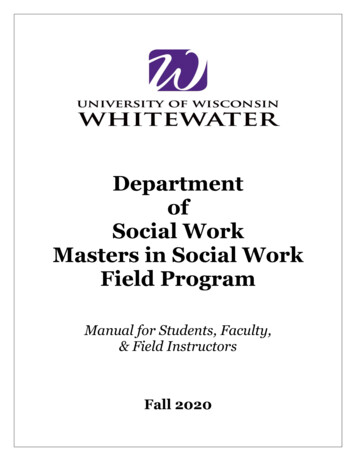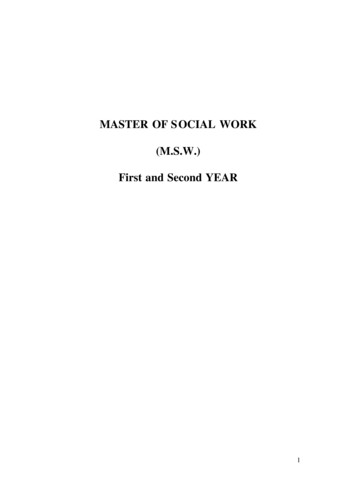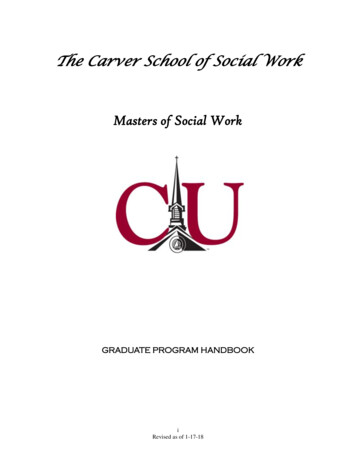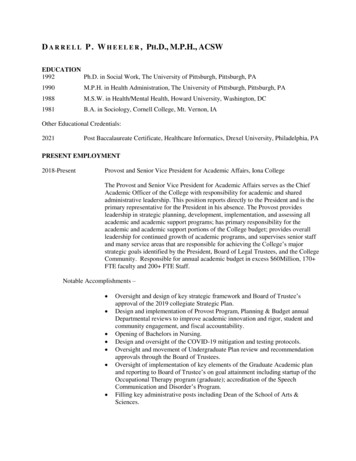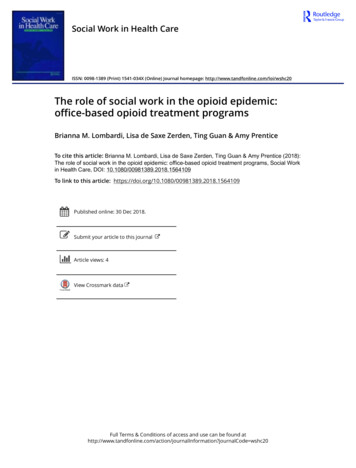
Transcription
Social Work in Health CareISSN: 0098-1389 (Print) 1541-034X (Online) Journal homepage: http://www.tandfonline.com/loi/wshc20The role of social work in the opioid epidemic:office-based opioid treatment programsBrianna M. Lombardi, Lisa de Saxe Zerden, Ting Guan & Amy PrenticeTo cite this article: Brianna M. Lombardi, Lisa de Saxe Zerden, Ting Guan & Amy Prentice (2018):The role of social work in the opioid epidemic: office-based opioid treatment programs, Social Workin Health Care, DOI: 10.1080/00981389.2018.1564109To link to this article: shed online: 30 Dec 2018.Submit your article to this journalArticle views: 4View Crossmark dataFull Terms & Conditions of access and use can be found tion?journalCode wshc20
SOCIAL WORK IN HEALTH he role of social work in the opioid epidemic:office-based opioid treatment programsBrianna M. Lombardia, Lisa de Saxe Zerdenb, Ting Guanb, and Amy PrenticecaSchool of Social Work, University of Pittsburgh, Pittsburgh, PA; bSchool of Social Work, University ofNorth Carolina at Chapel Hill, Chapel Hill, NC; cFamily Medicine, UNC Health Care, Chapel Hill, NCABSTRACTARTICLE HISTORYThe opioid epidemic is a national emergency in the United States.To meet the needs of individuals diagnosed with Opioid UseDisorder (OUD) office-based opioid treatment programs (OBOT)are quickly expanding. However, social workers roles in OBOTprograms are not clearly described. This paper will emphasizethree roles social workers may fulfill in OBOT programs to combatthe opioid crisis.Received 7 September 2018Accepted 22 December 2018KEYWORDSSocial Worker Roles;Integrated Care; Opioid UseDisorder; MedicationAssisted Treatment; OfficeBased Opioid TreatmentThe opioid crisis is recognized as a national emergency. U.S. deaths fromopioid overdose have reached epidemic proportions, as it is estimated 116people die every day from opioid overdose and in 2016 more than 63,000people died from drug-related overdoses (Hedegaard, Warner, & Miniño,2017; U.S. Department of Health and Human Services, 2018). In response tothis epidemic, health providers are quickly working to find solutions to treatopioid misuse. One approach that is gaining momentum to treat opioid usedisorders (OUD) is medication-assisted treatment (MAT), which traditionallyincludes a combination of medication and behavioral therapy. Since 2000, theuse of MAT has expanded to primary care settings, often called office-basedopioid treatment (OBOT). OBOT programs are regarded as an effective way tosignificantly increase access to care and to expand treatment of OUD (Fiellinet al., 2008; Alford et al., 2011). Yet, implementing MAT into primary carerequires a trained workforce to meet complex physical and behavioral healthneeds of OUD patients. The training and skills of social workers makes theprofession uniquely positioned to assist in implementing OBOT, particularlygiven social workers’ contributions in integrated settings (Fraser et al., 2018)and their ability to concurrently provide behavioral health interventions andaddress the psychosocial needs of individuals with OUD.The rapid expansion of OBOT programs came in part because of the DrugAddiction Treatment Act of 2000 that allowed qualified physicians to prescribe MAT in primary care whereas previous policy restricted MAT toopiate treatment programs (SAMHSA, 2018). While OBOT programs haveCONTACT Brianna M. Lombardi 2018 Taylor & Francisbrl77@pitt.eduSchool of Social Work, University of Pittsburgh
2B. M. LOMBARDI ET AL.increased, 95% of primary care physicians do not have the required DEAwaiver to deliver MAT (Rosenblatt, Andrilla, Catlin, & Larson, 2015). Manyphysicians report feeling unsure of their ability to provide the full extent ofcare needed by patients with OUD and some expressed concern about theclinical staff having the expertise to provide the psychosocial componentsrelated to MAT success (Netherland et al., 2009). Additional barriers includeconcerns related to administrative, staffing, and treatment criteria as mandated by federal guidelines (Netherland et al., 2009; SAMHSA, 2015).In order to provide OUD treatment that is “consistent with the patientcentered, integrated, and recovery-oriented standards of substance use treatment” (SAMSHA, 2015, para. 10), OBOT programs often include psychosocial, counseling, and care management services. Yet, recommendations forspecific psychosocial protocols, mental health interventions, or frequency ofservices vary (Korthuis et al., 2017). Several OBOT studies have explored therole of nurses as OBOT care managers, based on nurses’ ability to dispensethe pharmacotherapy component of MAT (a.k.a. the drug induction), as wellas monitor lab values and physical reaction of MAT (Korthuis et al., 2017).However, due to the mental health and psychosocial co-morbidities associated with OUD (Soeffing, Martin, Fingerhood, Jasinski, & Rastegar, 2009),the deployment of social workers in programs could benefit practices byhelping to meet the complex needs of patients.Currently, social workers constitute the largest group of providers of behavioralhealth services in the country (SAMSHA, 2006), but the extent to which socialworkers are involved in OBOT teams is unknown. Some OBOT models have usedsocial workers as part of the team, particularly with patients who have complicatedpsychosocial problems in combination of OUD, (i.e., homelessness or parentswith OUD; Kahn et al., 2017). Social workers’ roles in OBOT settings could mirrorthe profession’s expansion in integrated health settings, which was solidified withthe passage of the Patient Protection and Affordable Care Act in 2010 (Andrews,Darnell, McBride, & Gehlert, 2013; Stanhope, Videka, Thorning, & McKay, 2015).Because of their clinical training, social workers are well suited to enhance OBOTservices by coordinating MAT and providing additional treatment for psychosocial and behavioral health needs. For example, social workers on interprofessionalteams in integrated primary care settings use their skills to provide the screening,assessment, and treatment of behavioral health problems (Fraser et al., 2018;Zerden, Lombardi, Fraser, Jones, & Rico, 2018). Social workers are also wellequipped to apply a person-in-environment perspective, enabling them to identifythe biopsychosocial factors that influence the well-being of patients and families(Zerden et al., 2018). Further, social workers understand the community contextof addiction that can affect MAT retention, adherence, and success (Lundgren &Krull, 2018). A systematic review of interprofessional teams that include socialworkers in integrated primary care settings identified three primary social workroles or functions: (1) behavioral health specialists, (2) care managers, and (3)
SOCIAL WORK IN HEALTH CARE3community engagement specialists (Fraser et al., 2018). How these roles cantranslate specifically to OBOT settings are described below.Behavioral health specialistMany state programs require that patients who receive MAT concurrentlyreceive psychotherapy or mental health care. For example, North Carolinarequires OBOT programs to provide “a minimum of once monthly individualor group therapy sessions during the induction and stabilization phases oftreatment conducted by a behavioral health professional licensed to treat substance use disorders” (North Carolina Division of Medical Assistance, 2017,p. 19). MSW-level social workers are trained to provide mental health treatmentas part of a larger interprofessional team (Fraser et al., 2018). In addition to socialworkers’ expertise in screening and assessment for suicidality, depression, andother mental health needs, social workers understand brief evidence-basedtreatment modalities such as motivational interviewing among many others(Zerden et al., 2018). Social workers can fulfill state requirements to provideconcurrent behavioral health treatment when MAT is delivered.Care manager roleThe MAT literature often describes the role of care manager as a person whofacilitates OBOT services by monitoring treatment adherence and progress,coordinating referrals and appointments, and facilitating communication withthe interprofessional MAT team (Chou et al., 2016). Increasingly, social workersare fulfilling care manager roles in integrated primary care, OBGYN, andspecialty clinics (Fraser et al., 2018). Because social workers are already workingwithin integrated settings, the profession could adapt skills to fulfill care management roles in OBOT.Community engagement specialistAlthough not a traditional component of OBOT services, many OUD patientsare likely to benefit from care that addresses their psychosocial needs.A community-engagement specialist on the OBOT team could assess for physical needs (i.e., housing, food) and connect patients with community servicesthat may affect treatment retention or risk of relapse. Social workers on OBOTteams could bring a strengths-based and resilience-focused perspective to identify strengths and adapt services to be culturally inclusive (Zerden et al., 2018).Although the three roles are unique, social workers have the capacity tofulfill many of these functions simultaneously (Fraher, Richman, Zerden, &Lombardi, 2018). The ability to perform multiple functions on an
4B. M. LOMBARDI ET AL.interprofessional team makes social work a unique workforce with the flexibility to adapt to the needs of both the patient and the health care team.Next steps for social work education, practice, and researchAs the opioid epidemic continues to impact the lives of millions in the U.S.,added emphasis on the training, education, and deployment of a preparedsocial work workforce is critical to combatting this national emergency. Thecrucial role of behavioral health care has been recognized by the BehavioralHealth Workforce Expansion and Training (BHWET) grants funded by theHealth Resource and Service Administration (HRSA). With this mechanism,more than 65 social work programs were funded to expand the behavioralhealth workforce in integrated health settings. However, few of the BHWETprograms specialize in OUD specifically. A national study of 210 MSWprograms found that among accredited programs, only 14.3% offereda specialization focused on addiction and only 4.7% required one or morecourses on substance use (Wilkey, Lundgren, & Amodeo, 2013). Expandedtraining and content regarding substance use and OUD will be an essentialcomponent of social work education. Beyond additional OUD training specifically for social workers, education strategies must prepare a workforcewith competencies for interprofessional education (IPE) and collaborativepractice. Given that interprofessional teams deliver OBOT, IPE is oneapproach to better prepare the future workforce on a shared understandingof the medical terminology associated with OUD and MAT processes.Continued researchAlthough research on the efficacy of MAT in OBOT programs is robust, littleresearch is available on the psychosocial components of MAT in primarycare settings. Some evidence supports that behavioral health interventionpromotes MAT success (Chou et al., 2016), however findings are mixed(Lagisetty et al., 2017). Refining the evidence of psychosocial componentsof OBOT will enhance clinical guidelines for social work practice and willimprove future training in these care models. Future research to evaluateteam composition of successful OBOT teams and the added value that socialworkers bring to interprofessional teams is needed.ConclusionBoth the treatment of OUD and the role of social workers in integratedprimary care settings are quickly expanding. Given the foundation of socialworkers’ education and training, these professionals can be deployed inflexible roles to address behavioral health concerns, coordinate and manage
SOCIAL WORK IN HEALTH CARE5plans of care, and connect OUD patients with community resources tomitigate psychosocial needs that might influence successful treatment.Social work education needs a renewed focus on preparing social workersto treat substance misuse and on developing competencies needed for working in collaborative and interprofessional integrated health settings. Researchon social work practice specific to OBOT settings is critical. Social work hasthe potential to impact the opioid epidemic – now is the time to engage thisworkforce across primary care settings.ReferencesAlford, D. P., LaBelle, C. T., Kretsch, N., Bergeron, A., Winter, M., Botticelli, M., &Samet, J. H. (2011). Collaborative care of opioid-addicted patients in primary care usingbuprenorphine: Five-year experience. Archives of Internal Medicine, 171(5), s, C. M., Darnell, J. S., McBride, T. D., & Gehlert, S. (2013). Social work andimplementation of the Affordable Care Act. Health & Social Work, 38(2), 67–71.doi:10.1093/hsw/hlt002Chou, R., Korthuis, P. T., Weimer, M., Bougatsos, C., Blazina, I., Zakher, B., McCarty, D.(2016). Medication-assisted treatment models of care for opioid use disorder in primarycare settings (Technical briefs No. 28,Report No. 16 (17)-EHC039-EF). Rockville, MD:Agency for Healthcare Research and Quality. Retrieved from ookshelf NBK402352.pdfFiellin, D. A., Moore, B. A., Sullivan, L. E., Becker, W. C., Pantalon, M. V.,Chawarski, M. C., Schottenfeld, R. S. (2008). Long term treatment with buprenorphine/naloxone in primary care: Results at 2–5 years. American Journal on Addictions, 17,116–120. doi:10.1080/10550490701860971Fraher, E. P., Richman, E. L., Zerden, L. D., & Lombardi, B. M. (2018). Social work studentand practitioner roles in integrated care settings. American Journal of PreventativeMedicine, 54(6S3), S281–S289. doi:10.1016/j.amepre.2018.01.046Fraser, M. W., Lombardi, B. M., Wu, S., Zerden, L. D., Richman, E. L., & Fraher, E. (2018).Social work in integrated primary care: A systematic review. Journal for the Society of SocialWork and Research, 9(2), 175–215. doi:10.1086/697567Hedegaard, H., Warner, M., & Miniño, A. M. (2017). Drug overdose deaths in the UnitedStates, 1999–2016 (NCHS Data Brief No. 294). Hyattsville, MD: National Center for HealthStatistics. Retrieved from Kahn, L. S., Mendel, W. E., Fallin, K. L., Borngraber, E. A., Nochajski, T. H., Rea, W. E., &Blondell, R. D. (2017). A parenting education program for women in treatment foropioid-use disorder at an outpatient medical practice. Social Work in Health Care, 56,649–665. doi:10.1080/00981389.2017.1327470Korthuis, P. T., McCarty, D., Weimer, M., Bougatsos, C., Blazina, I., Zakher, B., Chou, R.(2017). Primary care-based models for the treatment of opioid use disorder: A scopingreview. Annals of Internal Medicine, 166(4), 268–278. doi:10.7326/M16-2149Lagisetty, P., Klasa, K., Bush, C., Heisler, M., Chopra, V., & Bohnert, A. (2017). Primary caremodels for treating opioid use disorders: What actually works? A systematic review. PloSone, 12(10), e0186315. doi:10.1371/journal.pone.0186315
6B. M. LOMBARDI ET AL.Lundgren, L., & Krull, I. (2018). Screening, assessment, and treatment of substance usedisorders: Evidence-based practices, community and organizational setting in the era ofintegrated care. New York, NY: Oxford University Press.NC Division of Medical Assistance. (2017). Medicaid and health choice office-based opioidtreatment: Clinical coverage policy 1A-41 Retrieved from https://files.nc.gov/ncdma/documents/files/1A-41 3.pdfNetherland, J., Botsko, M., Egan, J. E., Saxon, A. J., Cunningham, C. O., Finkelstein, R., Weiss, L. (2009). Factors affecting willingness to provide buprenorphine treatment. Journalof Substance Abuse Treatment, 36, 244–251. doi:10.1016/j.jsat.2008.06.006Rosenblatt, R. A., Andrilla, C. H. A., Catlin, M., & Larson, E. H. (2015). Geographic andspecialty distribution of US physicians trained to treat OUD. Annals of Family Medicine,13, 23–26. doi:10.1370/afm.1735Soeffing, J. M., Martin, L. D., Fingerhood, M. I., Jasinski, D. R., & Rastegar, D. A. (2009).Buprenorphine maintenance treatment in a primary care setting: Outcomes at 1 year.Journal of Substance Abuse Treatment, 37(4), 426–430. doi:10.1016/j.jsat.2009.05.003Stanhope, V., Videka, L., Thorning, H., & McKay, M. (2015). Moving toward integratedhealth: An opportunity for social work. Social Work in Health Care, 54, ce Abuse and Mental Health Services Administration. (2015). Federal guidelines foropioid treatment programs. Retrieved from EOTP/PEP15-FEDGUIDEOTP.pdfSubstance Abuse and Mental Health Services Administration. (2018). Legislation, regulations,and guidelines. Retrieved from lines#DATA-2000Substance Abuse and Mental Health Services Administration, Center for Mental HealthServices. (2006). Mental health, United States 2004. Retrieved from MA06-4195.pdfU.S. Department of Health and Human Services (2018). About the Epidemic. Retrieved /index.htmlWilkey, C., Lundgren, L., & Amodeo, M. (2013). Addiction training in social work schools:A nationwide analysis. Journal of Social Work Practice in the Addictions, 13(2), 192–210.doi:10.1080/1533256X.2013.785872Zerden, L. D., Lombardi, B. M., Fraser, M. W., Jones, A., & Rico, Y. G. (2018). Social work:Integral to interprofessional education and integrated practice. Journal of InterprofessionalEducation & Practice, 10, 67–75. doi:10.1016/j.xjep.2017.12.011
The role of social work in the opioid epidemic: office-based opioid treatment programs Brianna M. Lombardia, Lisa de Saxe Zerden b, Ting Guan , and Amy Prenticec aSchool of Social Work, University of Pittsburgh, Pittsburgh, PA; bSchool of Social Work, University of North Carolina at Chapel Hill, Chapel Hill, NC; cFamily Medicine, UNC Health Care, Chapel Hill, NC



